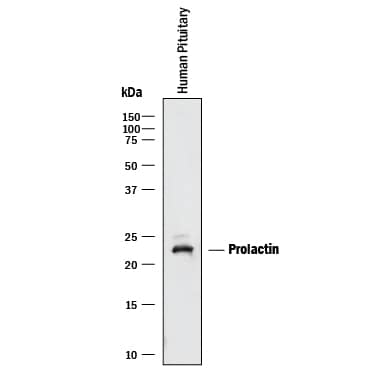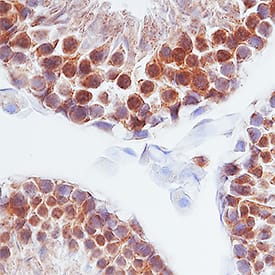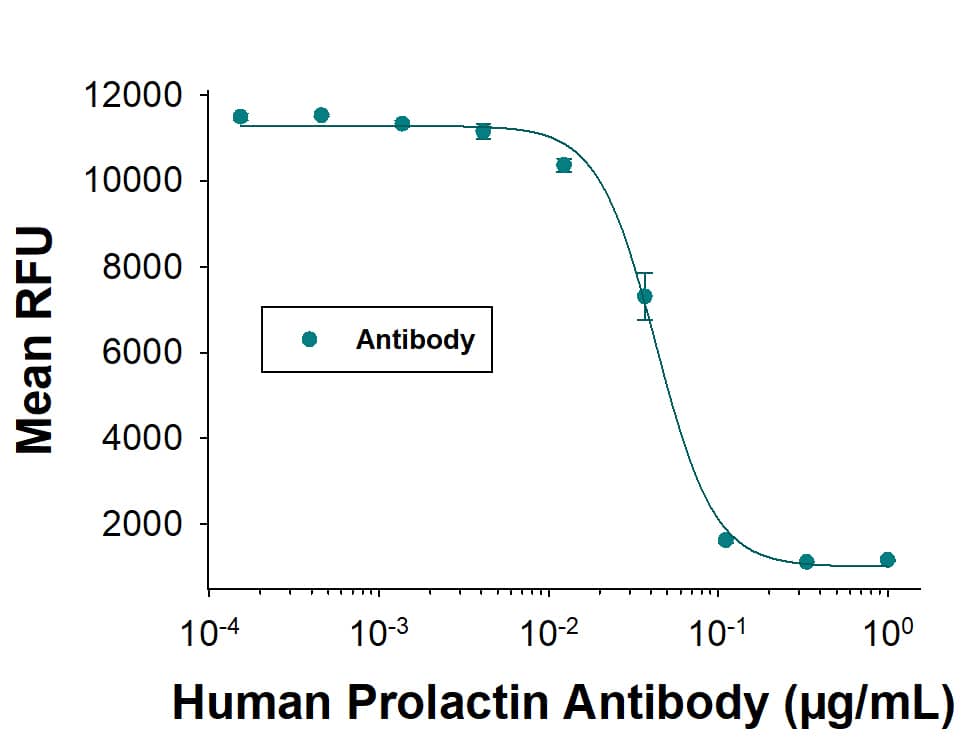Human Prolactin Antibody
R&D Systems, part of Bio-Techne | Catalog # AF682


Key Product Details
Species Reactivity
Validated:
Cited:
Applications
Validated:
Cited:
Label
Antibody Source
Product Specifications
Immunogen
Leu29-Cys227
Accession # Q5THQ0
Specificity
Clonality
Host
Isotype
Endotoxin Level
Scientific Data Images for Human Prolactin Antibody
Detection of Human Prolactin by Western Blot.
Western blot shows lysates of human pituitary tissue. PVDF membrane was probed with 0.25 µg/mL of Goat Anti-Human Prolactin Antigen Affinity-purified Polyclonal Antibody (Catalog # AF682) followed by HRP-conjugated Anti-Goat IgG Secondary Antibody (Catalog # HAF017). A specific band was detected for Prolactin at approximately 23 kDa (as indicated). This experiment was conducted under reducing conditions and using Immunoblot Buffer Group 1.Prolactin in Human Testis.
Prolactin was detected in immersion fixed paraffin-embedded sections of human testis using Goat Anti-Human Prolactin Antigen Affinity-purified Polyclonal Antibody (Catalog # AF682) at 1 µg/mL overnight at 4 °C. Tissue was stained using the Anti-Goat HRP-DAB Cell & Tissue Staining Kit (brown; Catalog # CTS008) and counterstained with hematoxylin (blue). Specific staining was localized to cytoplasm of sperm cells. View our protocol for Chromogenic IHC Staining of Paraffin-embedded Tissue Sections.Detection of Human Prolactin by Simple WesternTM.
Simple Western shows lysates of human pituitary, loaded at 0.2 mg/ml. A specific band was detected for Prolactin at approximately 30 kDa (as indicated) using 2.5 µg/mL of Goat Anti-Human Prolactin Antigen Affinity-purified Polyclonal Antibody (Catalog # AF682). This experiment was conducted under reducing conditions and using the 12-230kDa separation system.Applications for Human Prolactin Antibody
Immunohistochemistry
Sample: Immersion fixed paraffin-embedded sections of human testis
Simple Western
Sample: Human pituitary tissue
Western Blot
Sample: Human pituitary tissue
Neutralization
Human Prolactin Sandwich Immunoassay
Formulation, Preparation, and Storage
Purification
Reconstitution
Formulation
*Small pack size (-SP) is supplied either lyophilized or as a 0.2 µm filtered solution in PBS.
Shipping
Stability & Storage
- 12 months from date of receipt, -20 to -70 °C as supplied.
- 1 month, 2 to 8 °C under sterile conditions after reconstitution.
- 6 months, -20 to -70 °C under sterile conditions after reconstitution.
Background: Prolactin
Prolactin (PRL) is a neuroendocrine pituitary hormone. Prolactin is synthesized by the anterior pituitary, placenta, brain, uterus, dermal fibroblasts, decidua, B cell, T cells, NK cells, and breast cancer cells. Originally characterized as a lactogenic hormone, studies have demonstrated broader roles in breast cancer development, regulation of reproductive function, and immunoregulation. In the immune system, prolactin has been shown to be secreted by human PBMC and to act as a proliferative growth factor. Additionally, prolactin treatment of human PBMC has been shown to enhance IFN-gamma production. Prolactin has several molecular forms. The predominant form is a monomer, the non-glycosylated form is 23 kDa and the glycosylated form is 25 kDa. Glycosylated prolactin is removed from the circulation faster and has been reported to have lower biological potency. Prolactin cDNA encodes a 227 amino acid residue protein with a putative 28 aa residue signal peptide. The prolactin receptor is a transmembrane type I glycoprotein that belongs to the cytokine hematopoietic receptor family. B cells, T cells, macrophages, NK cells, monocytes, CD34+ progenitor cells, neutrophils, mammary gland, liver, kidney, adrenals, ovaries, testis, prostrate, seminal vesicles, and hypothalamus have all been shown to express the prolactin receptor. Three forms of the receptor, generated by differential splicing, have been identified. These isoforms differ in the length of their cytoplasmic domains. It is believed that the short cytoplasmic form is non-functional. Prolactin signal transduction involves the JAK/STAT families and Src kinase family.
References
- Cooke, N.E. et al. (1981) J. Biol. Chem. 256:4007.
- Ben-Johnson, N. et al. (1996) Endoc. Rev. 17:639.
- Cesario, T. et al. (1994) Proc. Soc. Exp. Biol. Med. 205:89.
- Price, A.E. et al. (1995) Endoc. 136:4827.
- Hoffmann, T. et al. (1993) J. Endoc. Invest. 16:807.
- Bellone, G. et al. (1995) J. Cell Physiol. 163:221.
- Cole, E. et al. (1991) Endoc. 129:2639.
- Lewis, U. et al. (1985) Endoc. 116:359.
Alternate Names
Gene Symbol
UniProt
Additional Prolactin Products
Product Documents for Human Prolactin Antibody
Product Specific Notices for Human Prolactin Antibody
For research use only


